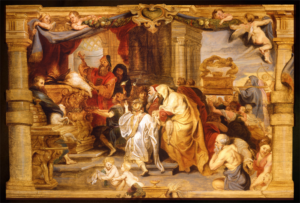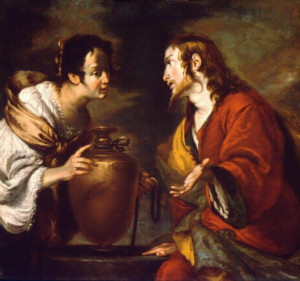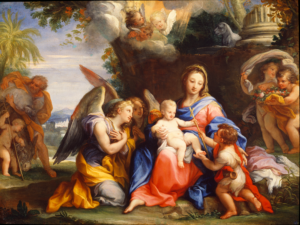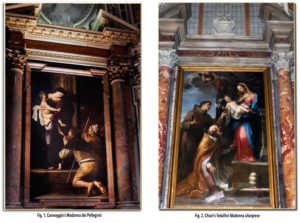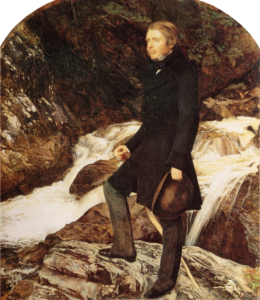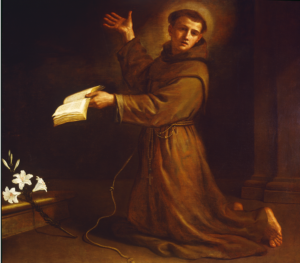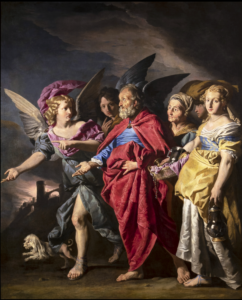Baroque Spanish artist Francisco Collantes relies on his considerable skill as a landscape painter to enhance the storytelling power of this Biblical narrative from Genesis 37.
Tag Archives: baroque art
View Works from the Museum & Gallery Collection
While the Museum & Gallery is closed to the public and unable to offer public viewing hours, we continue removing the collection in preparation for moving to a new building and new location. Meanwhile, you can still see selected paintings and objects on display in these campus locations:
Gustafson Fine Arts Center: Atrium
Public Hours: Monday-Friday, 8 AM-5 PM or by tour request
Who Needs Shakespeare?
In a world of Broadway, YouTube, and Netflix who needs Shakespeare? The simple answer, of course, is we do! Simplicity aside, however, there is no writer past or present whose plots and characters more powerfully illuminate the human condition. Political intrigue, treachery, hypocrisy, selfless heroism, nobility, and beauty—are all poignantly framed and astonishingly “contemporary” (ripped from the headlines of a 24-hour news cycle). We need Shakespeare because in a culture numbed by constant distractions and irrelevant “noise,” he reminds us of our place in the world and our potential for good—or evil.
Tour the Shakespeare Exhibition
Join M&G’s Director of Education, Donnalynn Hess for a FREE guided tour through M&G’s focus exhibition, Who Needs Shakespeare? on Thursday, June 26 at 3:30PM. You’ll discover insights into Shakespeare’s plots and characters through clever symbolism in paintings and engravings. Register to attend. Space is limited and for guests 7th grade and older only.
Register HERE.
War Memorial Chapel
Open only by appointment or tour request
The Benjamin West Collection
The seven, monumental paintings that hang in the War Memorial Chapel constitute the largest assemblage today of works from the Progress of Revealed Religion series commissioned by King George III to be painted by Benjamin West, the father of American painting.
Mack Library
Public Hours: Monday-Saturday, 10 AM-5 PM
View several Medieval and Renaissance objects from M&G’s collection, including a 16th-century Antiphonary, a 15th-century keepsake box made of bone, and more!
The Return from the Flight into Egypt
Oil on canvas, c. 1712
Giuseppe Bartolomeo Chiari
Roman, 1654-1727
Rome was for centuries the epicenter of culture, art, and religion. At the time of Giuseppe Chiari’s birth, it was also “the scene of a lively debate with a constantly varying interplay of influences, trends, fashions, specialized treatises, and, of course, great masterpieces” (Zuffi, p. 64). At the center of this debate were three artistic movements that Zuffi notes “succeeded one another in a sort of ideal relay race of artistic styles.” The stark naturalism of Caravaggio, the elegant classicism of Annibale Carracci, and the dramatic baroque sculptures and architecture of Gian Lorenzo Bernini would all play a part in making 17th-century Rome—well, Rome!
As president of the Roman Academy Carlo Maratta was keenly aware of these lively debates. Considered one of the most important painters in the latter half of the 17th century, he was much admired for his beautiful frescos and stunning portraits. Although his work evidenced a clear admiration for the classical tradition, several of his paintings also integrated elements of Caravaggio’s vigorous style. David Steel points out that Maratta often “managed to steer a middle course between these two dominant and often contrary trends of baroque painting” (Steel, p. 88).
Maratta was at the summit of his career in 1666 when 12-year-old Giuseppe Chiari entered the great master’s studio. Chiari soon became a star pupil. Over the years, his profound respect for Maratta’s tutelage would not only shape his artistic development but also ensure his future success in a highly competitive environment. When Maratta died in 1713, Chiari took up Maratta’s mantle and became the dominant Roman artist.
Like Maratta, Chiari broadened his appeal by becoming an astute observer and deft practitioner of integrating stylistic trends. Kathrine and William Wallace highlight this skill in their comparative analysis of Chiari’s Tedallini altarpiece with Caravaggio’s Madonna dei Pellegrini [figs. 1 and 2]:
“The statuesque pose of Chiari’s Madonna, the unusually high step on which she stands, the elongated form of the Christ child framed by a white swaddling cloth, and the overall right-triangular composition recall Caravaggio’s Madonna dei Pellegrini. Yet the suggestion is subtle: Chiari has reversed the composition, naturalized the pose of the Virgin, and substituted the more palatable, well-dressed saints for the dirty feet and common character of Caravaggio’s pilgrims. Although inspired by Caravaggio, Chiari’s altarpiece remains distinctly his own. Chiari’s Madonna looks like a person of warm flesh and blood rather than the marmoreal statue of Caravaggio’s Madonna; Christ is an attractive child of sweet disposition as opposed to the enormous and ungainly figure depicted by the older master. Instead of the muted and earthy colors of the Madonna dei Pellegrini, Chiari’s bright hues are immediately pleasing and a welcome contrast to the comparatively dark paintings found on so many Roman altars” (p. 4).
The Return from the Flight into Egypt provides another example of Chiari’s virtuosity and unique style. Here, however, he turns from echoing the past to adumbrating the future. The refined handling of the paint and elegant figural poses pay homage to the classical tradition; however, the playfulness, delicate coloration, and ornamental enrichment mark the transition into the sensuous, intimate style of the rococo movement which emerged in France and spread throughout Europe in the 18th century (Chilvers, 507).
M&G has two works by Chiari on this subject, one titled The Rest on the Flight into Egypt and this rendering titled The Return from the Flight into Egypt. Over the years scholars have found the less traditional title of this 1712 work problematic. However, “the light-hearted, almost celebratory mood” (echoed in the Rococo style) reinforce the idea that here, Chiari intends to highlight the family’s return from rather than flight into Egypt. Regardless of the debate, art experts like Christopher Johns note that this picture may be the best example of Chiari’s work in America.
Donnalynn Hess, M&G Director of Education
Resources:
Baroque Paintings from the Bob Jones University Collection by David H. Steel
Concise Dictionary of Art and Artists, 3rd edition by Ian Chilvers
“Giuseppe Bartolomeo Chiari,” The Art Bulletin, March, 1968, Vol. 50, No. 1 by Bernhard Kerber and Franciscono Renate
“Seeing Chiari Clearly,” Artibus Et Historiae, 2012, Vol. 33, No. 66 by Katherine M. Wallace and William Wallace
Published 2024
Although little is known about the Italian artist Pietro Martire Neri, this portrait illustrates his stunning mastery of beautiful coloration and intricate stylistic detail.
The Flight from Sodom
Oil on canvas, c. 1630
Matthias Stomer
Dutch, c. 1600–after 1649
Very little is known about the artistic training of Dutch master Matthias Stomer. His works have similarities to Gerrit van Honthorst and Abraham Janssens, both in M&G’s collection. He spent some time in Rome being influenced by Caravaggio as did many of his contemporary fellow artists. He seems to have settled in Sicily and painted many biblical subjects. Though some think M&G’s The Flight from Sodom is derivative of a Rubens’ work of the same title at the Ringling in Sarasota, Florida, Stomer simply tells the “rest of the story.”
Genesis 19 reveals that the escape of Lot and his family from Sodom has two stages. First, God warns Lot of the impending destruction of Sodom for its immorality and wickedness and tells him to gather his family and escape the fate of the city. Unfortunately, his efforts are rebuffed by his sons-in-law. The delay means he is still in the city at daybreak. Then he is commanded, “Escape for thy life; look not behind thee, neither stay thou in all the plain; escape to the mountain.” But in fear, Lot begs to escape to a “little” city nearby rather than the mountain of God’s dictum. God mercifully allows this change, saving Zoar from destruction for Lot’s sake.
Stomer paints the second part of the drama: Lot’s negotiating his escape into Zoar. Lot’s wife is near the back of the group, signifying her growing reluctance to leave. Her faraway gaze shows her preoccupation with the past. She will eventually look back and be turned into a pillar of salt as punishment. In the foreground the blond daughter carries a basket of gold household items and engages the audience with a direct gaze. Is she asking for sympathy? For approval of her father’s plan? She definitely challenges the viewer to contemplate the event. The other daughter, mostly hidden, carries a cloth bundle on her head. She gazes straight ahead, intent on escaping with her life.
Lot clutches his red robe to him. Is he facilitating his gait or visually showing his reluctance to leave by grasping the rich garment that indicates his prominence? His raised eyebrows indicate a question for the leading angel. His open left palm indicates that the question asked is reasonable, almost a “what about?” gesture. The lead angel looks astonished at the request, mirroring Lot’s hand position with one hand while pointing definitively forward with the other, as if to say, “You want to go there?” The second angel’s hand lies near his chin, like the professor’s “stroking his beard” as he considers a student’s idea. Lot suggests a change of plan, and the angels seem to have differing opinions on it.
It may be reading too much into the painting to see in the half-shaved little dog a lesson that Lot and his family are escaping by the “skin of their teeth.” However, the running dog has more sense than Lot who has dawdled at every turn of the story, even with his life at stake. Stomer’s background indicates that the family has taken all night to leave the city (Genesis 19:16 states that the angels had to “set him without the city”). The morning has come—the time when Lot finishes his “flight” since “the sun was risen upon the earth when Lot entered into Zoar” (19:23). Ironically, even Stomer doesn’t finish the story. Lot and his daughters eventually find Zoar inhospitable, and the evil that Lot dreaded “in the mountain” comes to pass.
Dr. Karen Rowe Jones, M&G board member
Special Note:
Scholars have discovered that Stomer used “Naples yellow,” a color created by combining antimony and lead. First mentioned in the late 17th century, Naples yellow appears in Stomer’s early work. Determining whether the blond daughter’s robe uses Naples yellow, might facilitate dating The Flight from Sodom within Stomer’s oeuvre.
Botticelli, Michela, Costanza Miliani, Eva Luna Ravan, Claudia Caliri, and Francesco Paolo Romano. 2024. “Naples Yellow Revisited: Insights into Trades and Use in 17th-Century Sicily from the Macro X-ray Fluorescence Scanning of Matthias Stomer’s ‘The Mocking of Christ’” Heritage 7, no. 3: 1188-1201. https://doi.org/10.3390/heritage7030057
Published 2024
Monthly Update
Sign up here to receive M&G’s monthly update and collection news!
EXPLORE More Online Features
Speakers Bureau
We can speak for your retirement group, civic club, church fellowship, or book club. Contact us here or at 864-770-1331.
Support Our Work
Make a Gift to M&G to help our current work and future plans.
